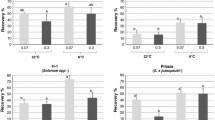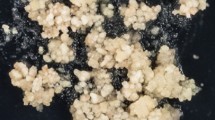Summary
The feasibility of developing an in vitro technique for screening drought-tolerant coconut germplasm has been investigated. Embryos excised from mature nuts of Sri Lanka-tall coconut were cultured as described previously. Water-stress in the culture system was progressively increased with each passage, by incorporating polyethylene glycol (PEG-6000), mannitol and sodium chloride into the culture medium. PEG and mannitol were observed to be growth inhibitory in action event at low concentrations and these two compounds were abandoned. In NaCl-stressed media, about 21% of randomly selected Sri Lanka-tall embryos died before reaching the 170 mM NaCl. About 78% survived 170 mM NaCl and only 12.6% were able to resist 320 mM NaCl. When zygotic embryos derived from two known drought-susceptible cultivars of coconut, CRIC-65 and Dwarf (from pumila) were tested using the same technique, 29% and 73% of embryos respectively died due to stress damage caused by 170 mM NaCl and none of either cultivar survived a salt concentration above 230 mM.
However, embryos originated from two putative drought-tolerant cultivars showed a higher survival rate when subjected to salt stress. At 170 mM NaCl, all the embryos had developed into seedlings. In fact, percent germination of embryos was somewhat higher in 170 mM NaCl than in the control, that was devoid of NaCl. However, percent survivors gradually dropped with increase in salt concentration and about 18% survived the 330 mM NaCl. The technique seems to have great potential in screening drought-tolerant coconut germplasm.
Similar content being viewed by others
References
Ashraf, C.M. & S. Abu-Shakra, 1978. Wheat seed germination under low temperature and moisture stress. Agron. J. 70: 135–139.
Ben-Hayyim, G. & J. Kochba, 1983. Aspects of salt tolerance in a NaCl-selected stable cell line of Citrus sinensis. Plant Physiol. 72: 685–690.
Croughan, T.P., S.J. Stavarek & D.W. Rains, 1982. In vitro development of salt resistant plants. Environ. Expt. Bot. 21: 317–324.
Eeuwens, C.J., 1978. Effects of organic nutrients and hormones on growth and development of tissue explants from coconut (Cocos nucifera) and data (Phoenix dactylifera) palms cultured in vitro. Physiol. Plant 42: 173–178.
Fernando, W.M.Ursla, 1987. San Ramon-Big with promise. Cocon. Bull. 4: 15.
Heyser, J.W. & M.W. Nabors, 1981. Growth, water content and solute accumulation of two tobacco cell lines cultured on NaCl, dextran and polyethylene glycol. Plant Physiol. 68: 1454–1459.
Heyser, J.W. & M.W. Nabors, 1981a. Osmotic adjustment of cultured tobacco cells (Nicotiana tabacum var. Samsum) grown on sodium chloride. Plant Physiol. 67: 720–727.
Hurd, E.A., 1974. Phenotype and drought tolerance in wheat. Agric. Meterol. 19: 39–55.
Karunaratne, S., C. Kurukulaarachchi & C. Gamage, 1985. A report on the culture of embryos of dwarf coconut, Cocos nucifera L var nana, in vitro. COCOS 3: 1–8.
Levitt, J., 1980. Salt stress. pp 365–454. In: J. Levitt (Ed.). Responses of plants to environmental stresses. Academic Press.
Maas, E.V. & R.H. Nieman, 1978. Physiology of plant tolerance to salinity. In: G.A. Yung (Ed.). Crop tolerance to suboptimal land conditions. American Society of Agronomy Special Publication. Crop Science Society of America, Madison, WI pp 277–299.
Nabors, M.W., S.F. Gibbs, C.S. Bernstein & M.E. Meis, 1980. NaCl-tolerant tobacco plants from cultured cells. Z. Pflanzenphysiol 97 13–17.
Parker, C.R., 1972. Part 1. pp 25. In: Water analysis by atomic absorption spectroscopy. Varian. Techtron. Springvale, Vic., Australia.
Pomier, M. & C. Brunin, 1974. Irrigation des cocotieres à l'eau salée. Oléagineux 29: 183–186.
Sullivan, C.Y. & W.M. Ross, 1979. Selecting for drought and heat resistance in grain sorghum. pp 263–281. In: H. Mussel & R.C. Staples, (Ed.). Stress physiology in crop plants. John Wiley and Sons. New York.
Wickremaratne, M.R.T., 1987. Breeding coconuts for adaptation to drought. Cocon. Bull. 4: 16–23.
Winter, S.R., J.T. Musick & K.B. Porter, 1988. Evaluation of screening techniques for breeding drought-resistant winter wheat. Crop Sci. 28: 512–514.
Author information
Authors and Affiliations
Rights and permissions
About this article
Cite this article
Karunaratne, S., Santha, S. & Kovoor, A. An in vitro assay for drought-tolerant coconut germplasm. Euphytica 53, 25–30 (1991). https://doi.org/10.1007/BF00032028
Received:
Accepted:
Issue Date:
DOI: https://doi.org/10.1007/BF00032028




